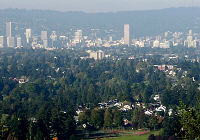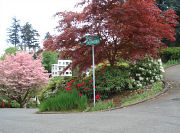SW Portland

Southwest Portland is roughly the area from the Willamette River west, and from Burnside south. Downtown Portland is included in this area, although locals will most often refer to that as simply “downtown” – when they say “Southwest” they’re usually referring to the rest of the quadrant. Be aware, however, that when you’re trying to get around using street addresses, downtown Portland addresses have a “SW” after the street number.
Unfortunately, when you get beyond the orderly grid of downtown, Southwest Portland becomes a bit more tricky to navigate. It includes several smaller communities which are notorious for their windy roads, and even locals sometimes have trouble finding their way around in them. Some of the neighborhoods within Southwest Portland which you may hear mentioned or want to visit are:
 The West Hills area is the primary neighborhood where you’ll find the older Portland mansions. While areas like the Pearl District may have higher property prices these days, the West Hills is the home of much of Portland’s old money. There are lots of beautiful homes which you can see easily from the roads – most of them don’t have big gates or hedges blocking the view – so if you want to see how the other half lives in Portland, you can take a driving tour. Just be sure you’ve either got a good map or a good guide, because the streets are crazily confusing. And they don’t call ’em the West Hills fer nuthin’ – if you’re on foot or a bicycle, it’s a helluva workout.
The West Hills area is the primary neighborhood where you’ll find the older Portland mansions. While areas like the Pearl District may have higher property prices these days, the West Hills is the home of much of Portland’s old money. There are lots of beautiful homes which you can see easily from the roads – most of them don’t have big gates or hedges blocking the view – so if you want to see how the other half lives in Portland, you can take a driving tour. Just be sure you’ve either got a good map or a good guide, because the streets are crazily confusing. And they don’t call ’em the West Hills fer nuthin’ – if you’re on foot or a bicycle, it’s a helluva workout.- South Waterfront is a newer development in Portland, and is currently still under construction. Oregon Health & Sciences University has a building down there, and it’s where the tram stop is, but the concept for this development is that it includes residential units, office space, restaurant space – pretty much everything the people who’ll be living there will need so that they won’t always have to be hopping in their cars. It’s an exercise in green living. You’ll be able to see the tall buildings rising on the banks of the Willamette River next to I-5, just south of the Ross Island Bridge.
- There are a few campuses in Southwest Portland which you may hear about, and one of them is clearly visible from some parts of the city. Oregon Health & Sciences University (OHSU) sits on a hill (known as “Pill Hill” overlooking downtown and the Willamette River. Further to the south, you’d find both Lewis & Clark College and the main campus of Portland Community College.
- Washington Park is up in the Southwest hills, and it’s full of attractions enjoyed by both locals and visitors – including the International Rose Test Garden, the Japanese Garden, the Oregon Zoo and the Hoyt Arboretum, as well as lots of hiking trails and tennis courts.
- I-405 cuts through Southwest Portland between 13th and 14th St., and Goose Hollow lies on the opposite side of the highway from downtown. There are restaurants, shops and office buildings in this area, although not as highly concentrated as downtown. Don’t be surprised if locals don’t refer to it as Goose Hollow, either.
- Lair Hill is south of downtown Portland and I-405, west of where the Ross Island Bridge connects with I-5. It’s primarily residential, although there are a few restaurants which are nice to try if you’re in the area, and it leads nicely down to the neighborhoods around Macadam Avenue and the small shopping center of John’s Landing.
- Even further south of downtown are some mainly residential areas like Multnomah Village, Hillsdale, and South Burlingame, each with its own main street with a a charming collection of shops and restaurants; but if you’re visiting Portland without a car and don’t have a reason to visit them, they’re not worth making the trip.
Southwest Portland stretches quite a ways south along both sides of I-5, so it’s sometimes hard to tell when you’re leaving Portland and entering any of the southern suburbs. However, unless you’re visiting someone who lives in the far reaches of Southwest, you’ll have no reason to try to navigate your way too far beyond downtown.